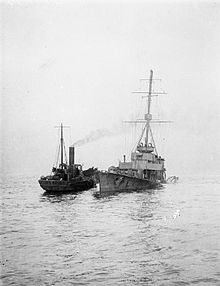HMS Arethusa (1913)
 Arethusa in 1914
| |
| History | |
|---|---|
| Name | HMS Arethusa |
| Namesake | Arethusa |
| Builder | Chatham Dockyard |
| Laid down | 28 October 1912 |
| Launched | 25 October 1913 |
| Commissioned | August 1914 |
| Fate | Damaged by mine, laid by SM UC-7, on 11 February 1916 and wrecked |
| General characteristics (as built) | |
| Class and type | Arethusa-class light cruiser |
| Displacement | 3,512 long tons (3,568 t) |
| Length | |
| Beam | 39 ft (11.9 m) |
| Draught | 15 ft 7 in (4.75 m) (mean, deep load ) |
| Installed power |
|
| Propulsion | 4 × shafts; 4 × steam turbines |
| Speed | 28.5 knots (52.8 km/h; 32.8 mph) |
| Range | 3,200 nmi (5,900 km; 3,700 mi) at 16 knots (30 km/h; 18 mph) |
| Capacity | 840 long tons (853 t) fuel oil |
| Complement | 270 |
| Armament |
|
| Armour |
|
HMS Arethusa was the
First World War, participating in the Battle of Heligoland Bight and the Battle of Dogger Bank
.
Design and description
The Arethusa-class cruisers were intended to lead
kW). The turbines used steam generated by eight Yarrow boilers which gave her a speed of about 28.5 knots (52.8 km/h; 32.8 mph).[2] She carried 840 long tons (853 t) of fuel oil[1] that gave a range of 3,200 nautical miles (5,900 km; 3,700 mi) at 16 knots (30 km/h; 18 mph).[3]
The main armament of the Arethusa-class ships consisted of two
Construction and career

She was laid down at
Cuxhaven Raid and on 24 January 1915 she fought at the Battle of Dogger Bank. Later in the same year, she was transferred to the 5th Light Cruiser Squadron of the Harwich Force. In September 1915, she captured four German trawlers. On 11 February 1916, she struck a mine off Felixstowe, drifted onto a shoal while under tow, and broke her back.[4] Approximately near Harwich (51.925, 1.295) [5][6]
Legacy
One of the four relief panels on Brierley Hill War Memorial, in Dudley, England, depicts Arethusa sending out its boats to rescue German sailors from a ship it had sunk.[7]
Notes
Bibliography
- ISBN 978-1-86176-281-8.
- ISBN 0-89839-256-X.
- ISBN 1-870423-74-7.
- Friedman, Norman (2010). British Cruisers: Two World Wars and After. Barnsley, South Yorkshire, UK: Seaforth. ISBN 978-1-59114-078-8.
- Friedman, Norman (2011). Naval Weapons of World War One. Barnsley, South Yorkshire, UK: Seaforth. ISBN 978-1-84832-100-7.
- Gardiner, Robert & Gray, Randal, eds. (1985). Conway's All the World's Fighting Ships 1906–1921. Annapolis, Maryland: Naval Institute Press. ISBN 0-85177-245-5.
- Newbolt, Henry (1996). Naval Operations. History of the Great War Based on Official Documents. Vol. V (reprint of the 1931 ed.). Nashville, Tennessee: Battery Press. ISBN 0-89839-255-1.
- Pearsall, Alan (1984). "Arethusa Class Cruisers, Part I". Warship. VIII. London: Conway Maritime Press: 203–11. ISBN 0-87021-983-9.
- Pearsall, Alan (1984). "Arethusa Class Cruisers, Part II". Warship. VIII. London: Conway Maritime Press: 258–65. ISBN 0-87021-983-9.
External links
Wikimedia Commons has media related to HMS Arethusa (ship, 1914).
